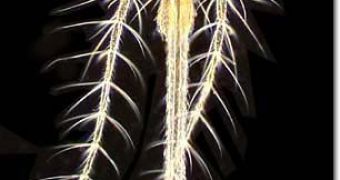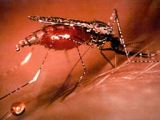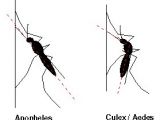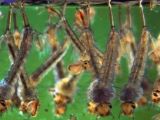Females can turn your life into a living hell.
That's literally in the case of the mosquitoes.
Mosquitoes are insects of the Order Diptera (thus related with the flies), suborder Nematocera ("with thin antennae"), and Culicidae family.
Mosquitoes are thought to have appeared during the Jurassic Epoch (the middle age of the dinosaur era) and now there are over 3,000 species worldwide, most of them located at the tropics.
Only the female bites and she does this on man but also on other vertebrates, from elephants to mice and turtles, sucking their blood.
This food is necessary for the development of the ovaries and maturing of the eggs.
Some species can develop without the female ingesting previously blood, but when the opportunity appears, they will do it (like in some Culex).
Mosquitoes possess olfactive and thermic organs onto their hairy pair of antennae and the three pairs of legs that head them to the their victim based on their expelled carbon dioxide, warmth and sweat(the anti-mosquito products for face and hands impair their ability to detect this).
The males do not bite; they eat just plant juices.
The sting of the mosquito may look simple but on microscope it's extremely complicated; it is formed of 6 pieces: two tubes, a salivary one and a feeding one, surrounded by two sharp mandibles and two scalpels with saw like teeth.
All 6 pieces are wrapped in a sheath that protects them on all their length.
The sting is implanted into the skin for a few mm till it reaches a minute blood vessel.
But the blood has the ability to clot, so, through the salivary tube, the mosquito female pumps anti-clotting chemicals that keep the blood fluid, so she can suck it easily.
The saliva that remains inside the skin results as being extremely irritating for the victim, causing an unbearable itch.
DO not scratch the bitten place.
The best solution is alcohol, which eases the pain.
The greatest problem may be not the itch, but the parasites that mosquitoes, mostly in tropics, can transmit through their saliva.
Anopheles mosquitoes transmit malaria, a blood parasite that kills between 1 to 3 million people annually and infects 300 million people each year on the tropics.
The Aedes mosquitoes are vectors for many viruses like those of the yellow fever, hepatitis or encephalitis.
A sole blood ingestion ensures the synthesis of hundreds of mosquito eggs.
Mosquitoes vary in their size from 1.6 mm to 12.5 mm (0.5 inch) and are abundant everywhere is warm and wet.
It is said that mosquitoes can fly between the rain droplets...
Mosquitoes can fly with 1.5-2.5 km (0.9-1.6 mi)/h at most 5 minutes at once with a wing rhythm of 250 beats/seconds!
This rhythm determines their buzz and they would like not to generate it; otherwise their presence would be undetectable till they bite.
Their step on the victim is so smooth that it cannot be detected.
They can even step on spider webs without the spider feel anything!...
In temperate zones, adult females winter in various sheltered places and when the winter is gone, they start feeding with blood and another mosquito generation is on the way.
Mosquitoes feed only in the evening and during the night; during the day, they shelter in dense vegetation, houses, farms; but in the tropics, there are species that bite even during the day.
Mosquitoes larvae are aquatic, and as little as the water from garbage cans, old tiles, barrels, washbasins, wet basements, bathrooms, kitchens, balconies is enough to ensure their development, combating the mosquito population in an area can result a tough task.
As the larvae breathe oxygen from the air, they are not affected by the water quality.
The mosquito eggs are very resistant to drought and cold, being able to resist till five years in cold and dry ground till the next warm rain, and in a week, the larvae go out from the eggs.
There are other insects from Nematocera that look like mosquitoes, are found also around waters and are completely harmless, as their females do not suck blood and they ingest just plant sap, like midges from Chironomidae, Tipulidae (crane flies) while other diptera that do not look quite like a mosquito, from Simuliidae (black flies), Ceratopogonidae (biting midges), Glossinidae (tsetse flies) families (only some examples) DO bite for blood and transmit extremely severe parasites, like sleeping sickness, and worms that provoke river blindness, filariasis or elephantiasis.

 14 DAY TRIAL //
14 DAY TRIAL // 


